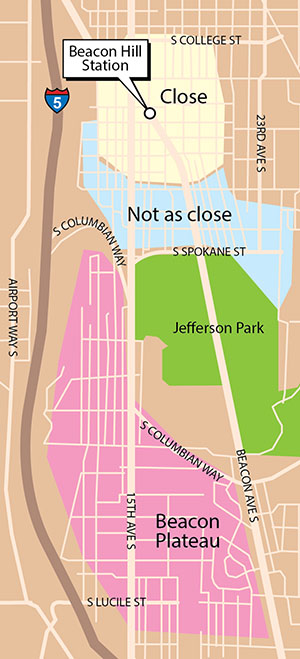|
Subscribe / Renew |
|
|
Contact Us |
|
| ► Subscribe to our Free Weekly Newsletter | |
| home | Welcome, sign in or click here to subscribe. | login |
Real Estate
| |

By Joe Nabbefeld |
June 26, 2014
Crib Notes: Are rail stations boosting home prices? Data crunch for Beacon Hill says yes
Special to the Journal
Down here in the trenches, it feels like the light rail station serving North Beacon Hill certainly has increased people's interest in living there. So my hunch is home prices are rising there because of the station.
Sales data from the Multiple Listing Service crunched by Crib Notes supports that conclusion. It's happening.
Homes closest to North Beacon Hill station sold for an average of $405,968 in 2013, the data shows. Similar-sized homes in an area I define as “not as close” sold for an average of $358,159 in 2013. Further away, on the Beacon Plateau west of the Jefferson reservoir park and the VA hospital, they averaged $313,410.
That's a 14 percent difference between homes on the Plateau and those “not as close,” and another 13 percent difference between “not as close” and “close” homes.
Like most any change, this has pros and cons. Winners and losers. Gains and losses.
As values rise, for example, someone gets priced out. Discussion then turns to tooling up a bunch of new construction there to ease the upward price pressure. Without new supply, those with lower incomes get pushed down the line, maybe to areas near the Columbia City and Othello stations.

Keep in mind, this kind of “price-out” is gradual, incremental and may be spread over decades. One homebuyer at a time.
So far though this change seems like a net win for the common good. Crib Notes likes seeing folks using transit we've all pooled our resources to build, and making their housing choices with transit in mind.
But this is an action story.
Many Realtors have buyers who say they want to be close to light rail. They want to be on North Beacon Hill. Some Realtors are even lucky enough to have a North Beacon seller.
So we do a comparative market analysis and go, “Hmmm... prices are pretty strong.” We tuck away the assumption that at least part of it is the draw of light rail. That's anecdotal; it can be wrong. We need data. Must. Have. Data.
First: What creates a real test? Then: How do we translate it? What does it really say? Finally: How can we be sure? Are we just cherry-picking?
For one thing, we use only “solds.” Then we draw a circle around the North Beacon station. (That's what we call “close” in our map here.)
We draw a second boundary, south of the “close” circle. More of an arc shape. This neighborhood is quite similar to — if not inherently a little stronger than — our “close” area, just a bit too far for most folks to walk regularly to light rail. We call this one “not as close.”
To strengthen the test, we draw a third boundary further away. Call this one Beacon Plateau. Still has views (but to the west, not the east). Similar housing stock. Still close to downtown. Just too far too walk to light rail.
Tension time. What will the numbers say?
All real estate stats contain so many variables. Man, they can be dazzlingly uninformative.
Recently we had a client at a tough spot in negotiations complain that she “hates all the ambiguity,” but there really are a lot of variables. Such as: Most of North Beacon's value increases are because the market overall is rising, right? Can't just randomly credit light rail for the boost.
Some of it stems from the Amazon effect. All those cash-flush Amazonians buying Capitol Hill and Queen Anne homes are pushing less-flush buyers south into Beacon regardless of light rail, right? Townhome builders might be starting to find fewer affordable sites north of Interstate 90 and turning to North Beacon just because land is cheaper — not because of light rail — right?
Each home has its variables, too, as does each buyer and each seller.
North Beacon's retail strip has gotten some fresh juice, or gentrification, in the form of a brassy new pizza place, yoga studios, a bar or two that seem to sell more wine than beer. Is this the result of light rail or would it have happened anyway? How much is that boosting nearby home values?
But we think the way we are structuring the data works through those factors.
We pulled only solds — any size home, including townhomes, but not condos — for 2013 in each of the three boundary areas.
Press the button. Here's what we see:
• The average price paid on Beacon Plateau: $313,410. Average size: 1,749 square feet.
For 2013, 75 homes sold. The lowest price: $302,000 for a 1,620-square-foot, 4-bedroom built in 1960 on a 6,000-square-foot lot. The highest: $579,950 for a 3,198-square-foot, 5-bedroom with 3 baths built in 2013 on a 7,207-square-foot lot.
• Average price in “not as close”: $358,159. Up 14 percent from the Plateau. Average size: 1,858 square feet.
For 2013, 21 sold. Lowest: $121,099 for a 580-square-foot, 2-bedroom, one-bath built in 1927 on an 1,800-square-foot lot. Highest: $562,000 for a 2,420-square-foot, 4-bedroom, 2.75-bath home built in 1926 on a 3,471-square-foot lot.
• Average price in “close”: $405,968. Up 13 percent from “not-close” and up 30 percent from Plateau. Average size: 1,856 square foot.
For 2013, 17 sold. Lowest: $259,950 for a 1,460-square-foot, 3-bedroom, 1-bath home built in 1914 on a 3,700-square-foot lot. Highest: $700,000 for a 3-bedroom, 2.5-bath, 2,410-square-foot home built in 2013 on a 3,150-square-foot lot.
Move a search boundary one block this way or that and the data shifts a bit. But these deltas cover that.
Here's a cross-check: We ran the same data, same boundaries, for the year 2007. Call that pre-light rail — and also the peak year. Values started plunging half-way through 2007).
Sure enough: Plateau average price: $409,748. Not as close: $423,040. Close: $402,849.
A second light rail station serves southern parts of the east slope of North Beacon — the Mount Baker station at McClellan and 23rd. Certain homes can be ideally positioned between the two stations. One walks downhill in the morning to the McClellan station to ride into downtown. Then walks downhill in the evening from North Beacon station to home.
Next time we'll take on the action of pinpointing what premium those homes command when they sell.
Whew such action! Time to hop the light rail.
Joe Nabbefeld is a Realtor with Windermere Capitol Hill. You can reach him at www.RealSolutions.biz. He was the DJC's commercial real estate editor back in the late 1990s and early 2000s.
Previous columns:
- Crib Notes: Slim pickings for Seattle house hunters, 05-22-2014
- Amazon is fueling a home-buying frenzy, 04-10-2014


